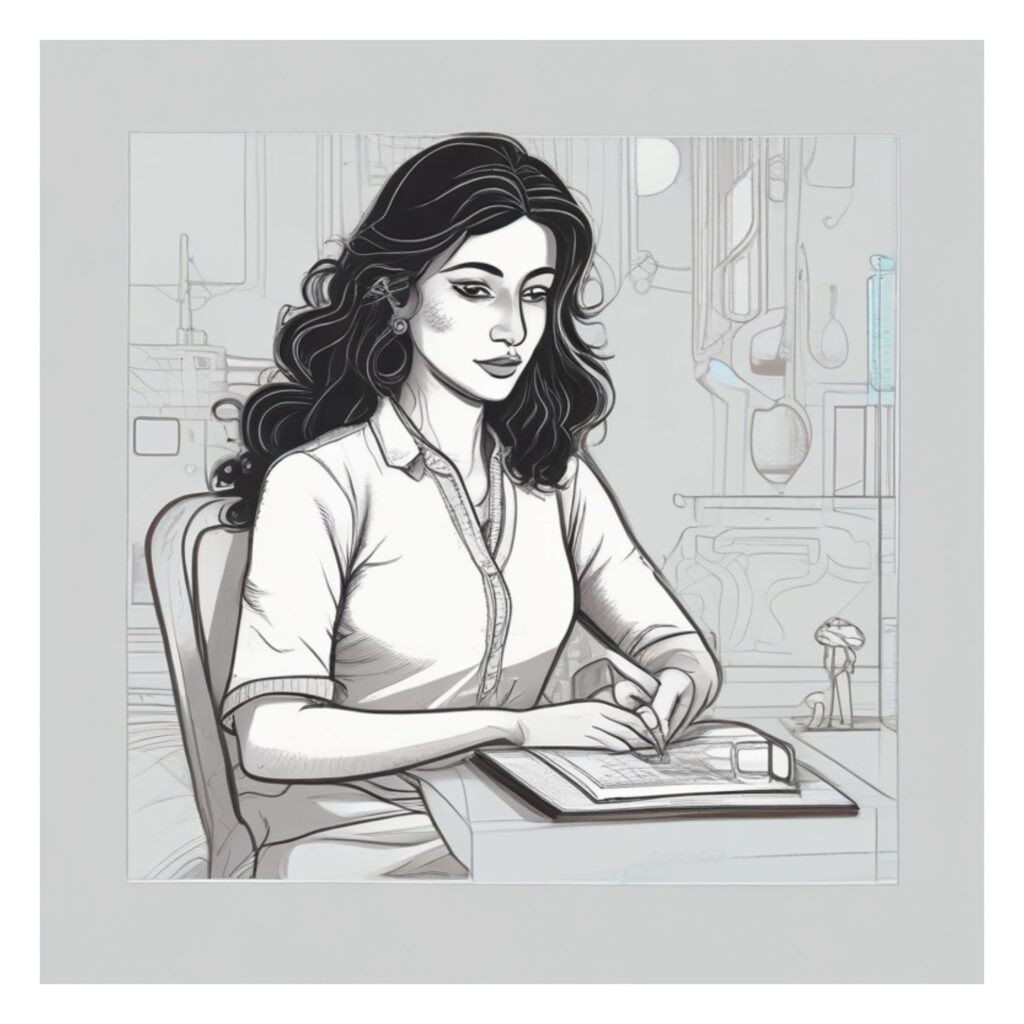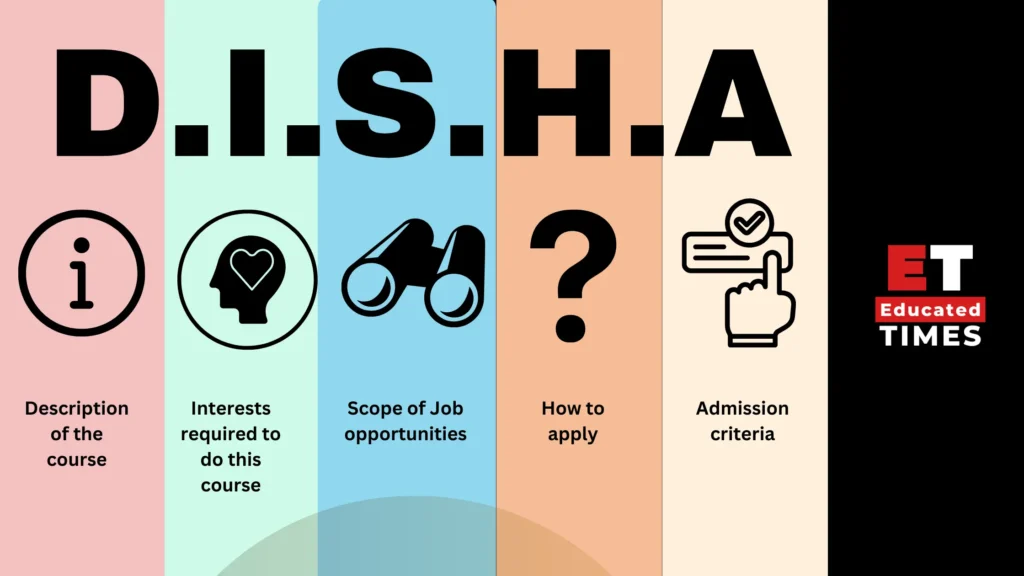Meera always saw the world differently. Where others saw ordinary objects, she envisioned beautiful designs. Her sketchbook overflowed with creative ideas, from sleek furniture to eye-catching logos. As she approached the end of her 12th standard, Meera knew her passion for design could become her career. But how?

One day, while researching career options, Meera stumbled upon information about the Bachelor of Design (B.Des) program. Her eyes lit up as she read about the diverse specializations and the blend of creativity and technical skills the course offered. However, the competitive entrance exams and top-tier colleges seemed daunting
Determined, Meera dove into preparation. She honed her sketching skills, studied design principles, and practiced for aptitude tests. Months of hard work paid off when she cleared the entrance exam for a prestigious design institute. As Meera stepped into her first B.Des class, she knew this was just the beginning of her exciting journey into the world of design.
Meera’s story is just one of many that unfold in the vibrant world of design education in India. Whether you’re a budding designer like her or simply curious about the field, join us as we explore the ins and outs of B.Des courses, from curriculum details to career prospects, and everything in between.

Table of Contents
Description of the Course
The Bachelor of Design (B.Des) is a 4-year undergraduate program that opens doors to the exciting world of design. This course is designed to nurture creativity, innovation, and problem-solving skills in various design disciplines. B.Des programs in India offer specializations in fields such as:
- Fashion Design
- Graphic Design
- Interior Design
- Product Design
- Textile Design
- Communication Design
- Industrial Design
The curriculum typically combines theoretical knowledge with practical applications, ensuring students gain a well-rounded understanding of design principles and their real-world implementation. Throughout the course, students work on projects, portfolios, and internships to develop their skills and prepare for professional careers in the design industry.
Interests Required to Do This Course
To excel in a B.Des program, students should have:
- Creativity and imagination
- Strong visual communication skills
- Interest in art, culture, and current trends
- Ability to think critically and solve problems
- Passion for design and aesthetics
- Willingness to experiment and take risks
- Good observational skills
- Interest in technology and digital tools
- Appreciation for user-centered design
- Ability to work both independently and collaboratively
Scope of Job Opportunities
The design industry in India is rapidly growing, offering numerous career opportunities for B.Des graduates. Some potential career paths include:
- Design Director
- Fashion Designer
- Textile and Surface Developer
- Graphic Designer
- Brand Manager
- User Experience (UX) Designer
- Product Designer
- Interior Designer
- Visual Merchandiser
- Design Consultant
- Art Director
- Web Designer
- Design Educator
The average starting salary for B.Des graduates ranges from INR 3-6 lakhs per annum, with experienced professionals earning significantly more based on their expertise and industry demand.
How to Apply
The application process for B.Des programs typically involves the following steps:
- Research and shortlist colleges offering B.Des programs
- Check the eligibility criteria and admission requirements for each college
- Register for relevant entrance examinations (e.g., UCEED, NIFT, NID DAT)
- Prepare for and appear in the entrance exams
- Apply to selected colleges through their official websites or application portals
- Submit required documents, including academic transcripts and entrance exam scores
- Participate in interviews or portfolio reviews if required by the institution
- Await results and accept admission offers
Admission Criteria
The general admission criteria for B.Des programs in India include:
- Minimum 50% aggregate marks in 10+2 or equivalent examination from a recognized board
- Qualifying scores in relevant entrance examinations (UCEED, NIFT, NID DAT, etc.)
- Portfolio submission (for some institutions)
- Personal interview (for some institutions)
- Proficiency in English language
Some institutions may have additional requirements or relaxations for specific categories of students.
Top 10 Colleges to Pursue B.Des in India
- National Institute of Fashion Technology (NIFT), Delhi
Website: https://nift.ac.in/ - Indian Institute of Technology (IIT) Bombay
Website: https://www.iitb.ac.in/ - National Institute of Design (NID), Ahmedabad
Website: https://www.nid.edu/ - Indian Institute of Technology (IIT) Guwahati
Website: https://www.iitg.ac.in/ - Srishti Institute of Art, Design and Technology, Bangalore
Website: https://srishti.ac.in/ - Pearl Academy, Delhi
Website: https://pearlacademy.com/ - MIT Institute of Design, Pune
Website: https://www.mitid.edu.in/ - Indian Institute of Technology (IIT) Hyderabad
Website: https://iith.ac.in/ - Delhi Technological University (DTU), Delhi
Website: http://dtu.ac.in/ - Institute of Design, Nirma University, Ahmedabad
Website: https://www.nirmauni.ac.in/id
Top 5 lesser-known facts about B.Des courses in India
- Interdisciplinary Approach:
Many B.Des programs in India incorporate elements from diverse fields such as psychology, sociology, and even neuroscience. This interdisciplinary approach helps students understand user behavior and create more empathetic designs. For instance, some courses include modules on cognitive psychology to enhance user interface design skills. - Sustainability Focus:
There’s a growing emphasis on sustainable design practices in B.Des curricula. Many programs now include specialized courses on eco-friendly materials, circular design principles, and sustainable fashion. This reflects the industry’s shift towards more environmentally conscious design practices. - Virtual Reality Integration:
Some cutting-edge B.Des programs are incorporating Virtual Reality (VR) and Augmented Reality (AR) technologies into their curriculum. Students learn to create immersive design experiences, which is particularly valuable in fields like interior design and product visualization. - Industry Mentorship Programs:
Several top B.Des institutes have established mentorship programs where industry professionals guide students throughout their course. These mentors provide real-world insights, help with portfolio development, and sometimes even offer internship opportunities that aren’t publicly advertised. - Design Entrepreneurship Modules:
Recognizing the potential for design-led startups, many B.Des courses now include modules on design entrepreneurship. These cover topics like design thinking for business, intellectual property rights for designers, and how to pitch design concepts to investors, preparing students for potential entrepreneurial ventures post-graduation.
FAQs
- Q: What is the difference between B.Des and B.Arch?
A: B.Des focuses on various design disciplines like fashion, graphic, and product design, while B.Arch specifically deals with architectural design and construction. - Q: Can I pursue a B.Des course after completing my 12th in any stream?
A: Yes, students from any stream (Science, Commerce, or Arts) can apply for B.Des programs, provided they meet the eligibility criteria set by the institution. - Q: Are there any age restrictions for applying to B.Des programs?
A: Most institutions don’t have strict age restrictions, but it’s best to check with individual colleges for their specific requirements. - Q: What skills should I develop to prepare for a B.Des entrance exam?
A: Focus on improving your drawing skills, visual perception, creativity, logical reasoning, and general knowledge about design and current affairs. - Q: Can I pursue higher studies after completing a B.Des degree?
A: Yes, you can pursue postgraduate programs like M.Des, MBA in Design Management, or specialized courses in your chosen design field. - Q: Is it necessary to have prior design experience before applying for a B.Des program?
A: While prior experience is not mandatory, having a basic understanding of design principles and some practice in sketching or digital design can be beneficial. - Q: What is the average fee structure for B.Des programs in India?
A: The average fees for a B.Des program range from INR 2-4 lakhs for the entire course duration, but this can vary significantly depending on the institution. - Q: Are there opportunities for internships during the B.Des course?
A: Yes, most B.Des programs include internship opportunities as part of their curriculum, allowing students to gain practical industry experience. - Q: Can I start my own design business after completing a B.Des degree?
A: Absolutely! Many B.Des graduates go on to start their own design studios or freelance businesses after gaining some industry experience. - Q: Are there job opportunities for B.Des graduates outside India?
A: Yes, design is a global field, and there are numerous opportunities for B.Des graduates to work internationally or with multinational companies.
Conclusion: Designing Your Future
The Bachelor of Design (B.Des) course in India offers a gateway to a world where creativity meets practicality, and innovation shapes our daily lives. From fashion to user experience, product design to visual communication, the field of design is as diverse as it is dynamic.
As we’ve explored throughout this guide, pursuing a B.Des degree requires passion, creativity, and dedication. The journey from entrance exams to final year projects is challenging, but it’s one that equips you with invaluable skills and perspectives. Whether you dream of designing the next revolutionary product, crafting stunning visual narratives, or reshaping spaces that inspire, a B.Des course can provide the foundation you need.
Remember, the design industry in India is rapidly evolving, offering exciting opportunities for those willing to push boundaries and think outside the box. The average starting salary of INR 3-6 lakhs per annum is just the beginning. With experience and expertise, the sky’s the limit for talented designers.
As you consider your options, reflect on your interests, research thoroughly, and don’t hesitate to reach out to alumni or professionals in the field. Your design journey is unique, and the right B.Des program can help you transform your creative vision into a fulfilling career.
Whether you see yourself as the next design entrepreneur or as part of a creative team in a multinational corporation, remember that every great design starts with a single idea. Your B.Des journey could be the first stroke in creating a masterpiece of a career.
So, are you ready to design your future?



